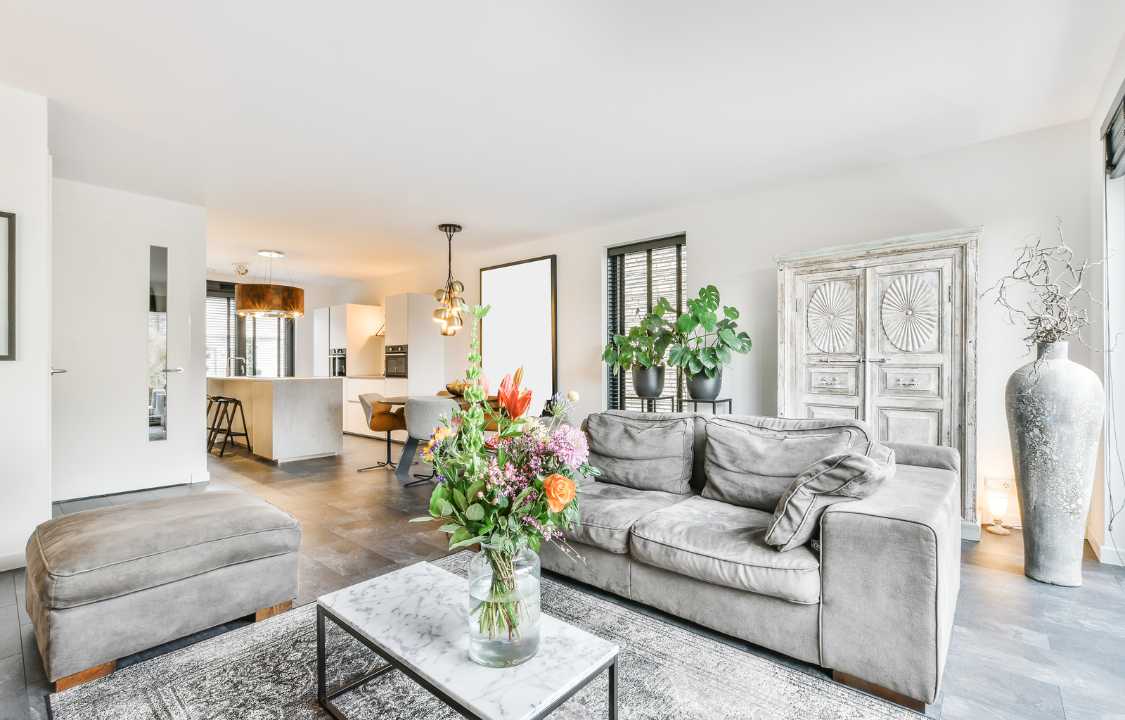When it comes to a functional living space it’s all about positioning your furniture in the right way
A well-arranged living room is the heart of a home, catering to relaxation and social gatherings. Mastering the art of arranging living room furniture involves fundamental principles that dictate functionality and aesthetics. Whether you’re contemplating a complete redesign, considering new furniture additions, or aiming to refresh your existing setup, a range of ingenious designer strategies can unlock your living room’s true potential.
Drawing on the expertise of renowned interior specialists, including the charismatic Laurence Llewelyn-Bowen and the sofa connoisseur Charlie Marshall, founder of Loaf, we delve into a treasure trove of living room ideas that breathe life into furniture arrangement.
The Foundation of Living Room Furniture Arrangement
1. Understanding Usage: Crafting a successful furniture arrangement begins with comprehending the room’s purpose and how it will be utilized. “Start with understanding the lines of sight and the room’s usage,” asserts Laurence Llewelyn-Bowen. Charlie Marshall echoes this sentiment, emphasizing the necessity of gauging how the space will be employed. A multifunctional space for television viewing, reading, studying, and entertaining necessitates careful planning for lighting, seating, and storage.
2. Selection of Focal Point: Designating a focal point is pivotal in harmonizing furniture placement. Laurence advocates steering clear of the common predicament of dual focal points—fireplace and television. Integrating the TV into a bookcase, as exemplified in Laurence’s home, exemplifies the ingenious blending of technology with decor. Charlie emphasizes the potential of furniture itself as a statement focal point, such as a striking armchair that captivates as one enters the room.
3. Furniture Spacing: The question of whether furniture should be pushed against walls or positioned more centrally remains a subject of debate. Charlie leans toward keeping furniture against walls to optimize space, particularly in smaller rooms. However, Laurence passionately advocates for avoiding the “agoraphobic” act of pushing furniture against walls, which limits the sense of space. The distance between furniture pieces and the walls significantly impacts the room’s perceived size.
4. Achieving Balance: A sense of equilibrium is key to an aesthetically pleasing living room arrangement. Lisa Mitchell, Design Director and Founder of Interior Style Studio, emphasizes the importance of focal point positioning and layering elements around it. A well-balanced arrangement involves considering the room as a cohesive picture, where subtle adjustments can make a world of difference. Charlie suggests avoiding overcrowding and maintaining a balanced distribution of furniture.
5. Steering Clear of Common Pitfalls: Striking the right balance between personal style and practicality is paramount. Charlie advises against excessive minimalism, advocating for the use of darker colors to create a cozy atmosphere. Laurence cautions against utilizing the fireplace as a feature wall, as its innate prominence negates the purpose of a feature wall. Comfort becomes a prime criterion; Lisa recommends testing sofas for comfort before purchase, preventing the disappointment of alluring yet uncomfortable seating.
The Coffee Table Dilemma
The inclusion of a coffee table in living room furniture remains a subject of contemplation. Laurence candidly admits his indifference towards coffee tables, which he believes shrink room space and obstruct movement. Advocating for smaller occasional tables, Laurence highlights their historic charm. Charlie counters this view by advocating for large coffee tables that create visual impact, serve as activity hubs, and accommodate games and reading materials. Lisa, on the other hand, leans towards a collection of round coffee tables at varying heights, while all experts applaud upholstered ottomans and storage footstools for their inviting aesthetics and functional versatility.
Shelving and Storage Considerations
Charlie aptly terms clever storage as the reigning monarch of interior design. Backless shelves emerge as versatile room dividers, offering both storage and zoning benefits. A versatile piece in any home, the sideboard finds favor among experts. Lisa underlines the importance of defining the purpose of the sideboard or shelves, with functional utility and aesthetic appeal in harmony.
In Conclusion
The orchestration of living room furniture arrangement transcends mere interior decoration; it embodies the harmonious convergence of artistic ingenuity and utilitarian pragmatism. A well-executed arrangement stands as a testament to the thought and consideration invested in a living space, a visual symphony that resonates with both aesthetic sensibilities and everyday functionality. Within the intricate dance of arranging furnishings, there exists a tapestry of principles that, when woven together, result in an arrangement that not only serves its purpose but also exudes an undeniable allure.
Delving into the world of interior design specialists, we uncover a treasure trove of insights that illuminate the path to an impeccable furniture layout. At the core of this process lies the profound appreciation for the room’s intended purpose. It is this guiding star that navigates the intricate journey, steering the arrangement towards a destination where form and function coalesce seamlessly.
The experts’ counsel shines a spotlight on several pivotal aspects that collectively culminate in an arrangement that is as visually captivating as it is practically adept. The first brushstroke on this canvas involves a profound understanding of lines of sight—the art of guiding one’s gaze within the room. With this knowledge, the placement of furniture becomes a deliberate exercise in visual choreography, ensuring that each piece is positioned in a manner that enhances both comfort and aesthetic continuity.
Central to this choreography is the embrace of focal points—those magnetic elements that draw the eye and lend the room its unique character. Whether it’s a grand fireplace, an expansive window with a view, or a captivating piece of art, these focal points become the anchors around which furniture revolves, creating a sense of purpose and cohesion.
Appropriate spacing of furniture is the next brushstroke, dictating the rhythm of movement within the room. This principle avoids the pitfalls of overcrowding or barren expanses, encouraging a natural flow that allows inhabitants to traverse the space with ease. In the delicate equilibrium between openness and coziness, comfort finds its home.
The final stroke in this artistic endeavor is the avoidance of common missteps. The experts’ guidance serves as a compass, steering clear of layout pitfalls that might inhibit functionality or dampen the visual impact. Armed with this wisdom, the arrangement evolves into a living tapestry—a manifestation of design knowledge, tailored to the unique context of the space.
Whether it’s pondering the proportions of coffee tables, exploring the myriad shelving possibilities, or embracing the timeless charm of sideboards, the experts’ teachings underscore the dynamic interplay between design and utility. Their wisdom serves as a bridge between creative expression and everyday living, transforming living rooms into captivating realms that speak to both the heart and the mind. In this dance between aesthetics and purpose, living spaces are not just adorned; they are elevated to the realm of living art.

